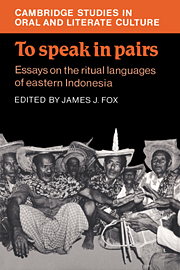Book contents
- Frontmatter
- Contents
- Illustrations
- The contributors
- Acknowledgements
- Introduction
- 1 Etiquette in Kodi spirit communication: the lips told to pronounce, the mouths told to speak
- 2 Method in the metaphor: the ritual language of Wanukaka
- 3 Li'i marapu: speech and ritual among the Wewewa of west Sumba
- 4 The Pattern of Prayer in Weyéwa
- 5 Fashioned speech, full communication: aspects of eastern Sumbanese ritual language
- 6 Manu Kama's road, Tepa Nilu's path: theme, narrative, and formula in Rotinese ritual language
- 7 The case of the purloined statues: the power of words among the Lionese
- 8 The journey of the bridegroom: idioms of marriage among the Endenese
- 9 A quest for the source: the ontogenesis of a creation myth of the Ata Tana Ai
- 10 The Tree of Desire: A Toraja ritual poem
- Notes
- References
- Index
5 - Fashioned speech, full communication: aspects of eastern Sumbanese ritual language
Published online by Cambridge University Press: 19 October 2009
- Frontmatter
- Contents
- Illustrations
- The contributors
- Acknowledgements
- Introduction
- 1 Etiquette in Kodi spirit communication: the lips told to pronounce, the mouths told to speak
- 2 Method in the metaphor: the ritual language of Wanukaka
- 3 Li'i marapu: speech and ritual among the Wewewa of west Sumba
- 4 The Pattern of Prayer in Weyéwa
- 5 Fashioned speech, full communication: aspects of eastern Sumbanese ritual language
- 6 Manu Kama's road, Tepa Nilu's path: theme, narrative, and formula in Rotinese ritual language
- 7 The case of the purloined statues: the power of words among the Lionese
- 8 The journey of the bridegroom: idioms of marriage among the Endenese
- 9 A quest for the source: the ontogenesis of a creation myth of the Ata Tana Ai
- 10 The Tree of Desire: A Toraja ritual poem
- Notes
- References
- Index
Summary
The largest part of eastern Sumbanese ritual life consists of speeches conducted in a formal style which, following common usage, can be called a ‘ritual language’. This paper has two principal aims: (1) to locate ritual language performances within the general scheme of eastern Sumbanese culture, paying particular attention to the value this idiom holds for members of this society, and (2) to review some of its most prominent formal features, concentrating especially on attributes which may prove to be of comparative interest. The data on which this paper is based are drawn from my own fieldwork carried out in the domain of Rindi. However, since eastern Sumba is both culturally and linguistically a largely homogeneous area, and because, with minor variations, the same ritual language tradition is found throughout this region, in what follows I shall for the most part refer to eastern Sumba, mentioning Rindi only where context requires.
General remarks
Eastern Sumbanese ritual language differs from ordinary discourse in several fundamental respects. Like similar and related traditions in other parts of Indonesia, it is most succinctly described in the phrase ‘formal, formulaic, and parallelistic’ (Fox 1971:215). Parallelism is evidenced by a prescribed pairing of words to form dyadic sets which appear as components of longer expressions, thus producing an overall pattern of paired lines or couplets. This principle affects both the semantics and syntax of ritual speech. Thus paired elements, which may provisionally be classified as comprising synonyms, various types of antithesis or ‘synthetic’ combinations, are usually morphologically identical and grammatically equivalent, and appear in corresponding positions within parallel lines.
- Type
- Chapter
- Information
- To Speak in PairsEssays on the Ritual Languages of eastern Indonesia, pp. 129 - 160Publisher: Cambridge University PressPrint publication year: 1988
- 8
- Cited by



